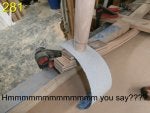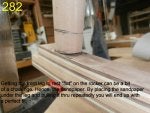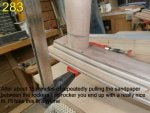Hi Guys, this is really a problem
I'm making living room tables for son and his spouse.
Since I don't have a lathe, I got some pretty nice ash legs on-line.
I was extremely careful about cutting the lumber for the initial skeleton that holds the legs equal.
I was building it on my cast iron table saw because I know it's true.
After I stained it, it began to wobble, seems like one of the legs is approx 1/16 shorter.
Any suggestions on how to square the legs??
Last thing I want to do is take it apart or start sawing.
Thanks,
Rich
First, make sure the floor is flat. Rotate the table/chair around, try on different spots on the floor. Even if the floor is not flat, if that is where you want to put the table/chair, you have to fix it.
Rocking is not usually a problem on a carpeted floor or rug, unless it is severe.
The easiest is to buy screw-in leveling felt feet.
http://www.rockler.com/product.cfm?page=5821
with
http://www.rockler.com/product.cfm?page=362
Put them on all four feet and wind out the legs that are high. Problem solved and the felt will be beneficial on a hard surface to prevent scratching.
Otherwise, you will need to trim some off the end of either or both of the long legs, the ones that remain in contact with the floor when it wobbles. There are two ways to do this and both require a flat reference surface.
Method 1 is to shim up the legs until it sits level on your reference surface. then mark up the same distance on each leg with a scribing compass or even a pencil laying flat on the surface. Use a thin kerf hand saw to cut all the legs to the marked line.
Method 2 is to use MDF or plywood as your reference surface. Drill a hole that fits your leg in the corner of the sheet where the long leg sits. Scrape down the surface the thickness of your saw kerf in that corner. Drop the long leg into the hole and make sure the other 3 legs are sitting flat on the surface. Trim off the long leg with a thin kerf saw.
Now that MultiMaster is on the scene and just about everybody has one... It's now cake and pie to trim table/chair legs...
You could build using just 3 legs..
Always build on a flat surface..
For wobbly tables/chairs add spindles/stretchers/bracing..
Note:
when you are leveling the chair/table place a lot of weight on the the chair/table to reduce flexing and act as clamping to hold the unit steady while you mark and cut...







